Analytical Research on the Bearing Characteristics of Oil Film Supplied with Constant Oil Flow Hydrostatic Turntables under Fixed Eccentric Load Condition
Abstract
:1. Introduction
2. Analytical Calculation Method for the Bearing Characteristics of Oil Film Supplied with Constant Oil Flow Hydrostatic Turntables under Fixed Eccentric Load Condition, Based on Equivalent Oil Film Thickness
2.1. Physical Model
2.2. Calculus Approach
- (1)
- Equivalent oil film thickness of any oil pad sealing oil edge
- (2)
- Flow Rate of any oil pad sealing oil edge
- (3)
- Bearing characteristics of oil film supplied with constant oil flow hydrostatic turntables after simplifying the analytical formalism
- (a)
- Bearing capacity of the entire oil film
is always a certain value for a constant flow supply of hydrostatic turntable [31].When the oil film thickness is certain, the pressure in any oil chamber is:The effective bearing area of the fan-shaped oil pad is:The bearing capacity of the whole oil pad is:- (b)
- Stiffness of the entire oil film
- (c)
- Overturning moment of the entire oil film
3. CFD Simulation Calculation
4. Experimental Analysis
4.1. Experimental Program
4.2. Analysis of Experimental Results
5. Analysis on the Influence of Working Parameters on Bearing Characteristics of Oil Film Supplied with Constant Oil Flow Hydrostatic Turntables under Fixed Eccentric Load Condition
5.1. Effects of Tilt Displacement Rate on Oil Film Thickness and Oil Chamber Pressure of Oil Pad
5.2. Effects of Tilt Displacement Rate on Bearing Capacity, Overturning Moment and Stiffness of Oil Film
5.3. Effects of Lubricant Flow on Bearing Capacity, Overturning Moment and Stiffness of Oil Film
5.4. Effects of the Rotation Speed on Bearing Capacity, Overturning Moment and Stiffness of Oil Film
6. Conclusions
Author Contributions
Funding
Institutional Review Board Statement
Informed Consent Statement
Data Availability Statement
Acknowledgments
Conflicts of Interest
References
- Ma, L.; Zhang, W.; Zhao, X.; Zhao, J.; Wang, T. Oil film characteristics and flow field analysis of asymmetrical hydrostatic support structure with full hydraulic fixed-length shear servo cylinder. Eng. Fail. Anal. 2021, 120, 105101. [Google Scholar] [CrossRef]
- Wang, Y.; Zhao, Y.; Cai, L.; Liu, Z.; Cheng, Q. Effects of thermal and hydrodynamic characteristics of heavy-duty rotary table on the hydrostatic circular pads. J. Vibroeng. 2016, 18, 4193–4206. [Google Scholar] [CrossRef] [Green Version]
- Kozdera, M.; Drábková, S. Numerical modeling of the flow in the annular multi-recess hydrostatic thrust bearing using CFD methods. EPJ Web Conf. 2013, 45, 01051. [Google Scholar] [CrossRef]
- Rehman, W.U.; Wang, X.; Chen, Y.; Yang, X.; Ullah, Z.; Cheng, Y.; Kanwal, M. An active control for hydrostatic journal bearing using optimization algorithms. Ind. Lubr. Tribol. 2021, 73, 316–324. [Google Scholar] [CrossRef]
- Alves, D.S.; Machado, T.H.; Cavalca, K.L.; Bachschmidb, N. Characteristics of oil film nonlinearity in bearings and its effects in rotor balancing. J. Sound Vib. 2019, 459, 114854. [Google Scholar] [CrossRef]
- Liu, C.; Hu, J. A FSI-thermal model to analyze performance characteristics of hydrostatic turntable. Ind. Lubr. Tribol. 2018, 70, 1692–1698. [Google Scholar] [CrossRef]
- Andrés, L.S.; Rohmer, M.; Wilkinson, S. Static Load Performance of a Water-Lubricated Hydrostatic Thrust Bearing. J. Eng. Gas Turbines Power 2017, 140, 062401. [Google Scholar]
- Liu, Z.; Zhan, C.; Cheng, Q.; Zhao, Y.S.; Li, X.Y.; Wang, Y.D. Thermal and tilt effects on bearing characteristics of hydrostatic oil pad in rotary table. J. Hydrodyn. 2016, 28, 585–595. [Google Scholar] [CrossRef]
- Dong, X.; Cai, L.; Liu, Z.; Zhao, Y.; Wang, Y. Research of Oil Film Characteristics of Hydrostatic Turntable under Rotation and Tilt. Int. J. Simul. Syst. Sci. Technol. 2016, 17, 8.1–8.9. [Google Scholar]
- Li, M.; Li, X.; Zhang, X.; Fan, R.; Cai, Y. An Investigation into the Mechanical Properties of Hydro-static Thrust Bearing for Constant Flow Circular Ring Oil Pad. Int. J. Simul. Syst. Sci. Technol. 2016, 17, 231–237. [Google Scholar]
- Gao, Q.; Qi, L.; Gao, S.; Lu, L.; Song, L.; Zhang, F. A FEM based modeling method for analyzing the static performance of aerostatic thrust bearings considering the fluid-structure interaction. Tribol. Int. 2021, 156, 106849. [Google Scholar] [CrossRef]
- Yu, X.; Geng, L.; Zheng, X.; Wang, Z.X.; Wu, X.G. Matching the relationship between rotational speed and load-carrying capacity on high-speed and heavy-load hydrostatic thrust bearing. Ind. Lubr. Tribol. 2018, 70, 8–14. [Google Scholar] [CrossRef]
- Liu, Z.; Wang, Y.; Cai, L.; Zhao, Y.; Cheng, Q.; Dong, X. A review of hydrostatic bearing system: Researches and applications. Adv. Mech. Eng. 2017, 9, 1687814017730536. [Google Scholar] [CrossRef]
- Liang, P.; Lu, C.; Pan, W.; Li, S. A new method for calculating the static performance of hydrostatic journal bearing. Tribol. Int. 2014, 77, 72–77. [Google Scholar] [CrossRef]
- Hsiao, S.T.; Kang, Y.; Jong, S.M.; Lee, H.H.; Peng, D.X.; Chang, Y.P. Static analysis of hydrostatic conical bearings using flow resistance network method. Ind. Lubr. Tribol. 2014, 66, 411–423. [Google Scholar] [CrossRef]
- Wu, L.; Song, B.; Zhou, Y.; Hao, M. Analysis on Oil Film of Hydrostatic Bearing in Gear Pump Operating at High Pressures and High Speeds. Int. J. Simul. Syst. Sci. Technol. 2016, 17, 25.1–25.4. [Google Scholar]
- Bouyer, J.; Wodtke, M.; Fillon, M. Experimental research on a hydrodynamic thrust bearing with hydrostatic lift pockets: Influence of lubrication modes on bearing performance. Tribol. Int. 2022, 165, 107253. [Google Scholar] [CrossRef]
- Gao, S.; Shang, Y.; Gao, Q.; Lu, L.; Zhu, M.; Sun, Y.; Yu, W. CFD-based investigation on effects of orifice length–diameter ratio for the design of hydrostatic thrust bearings. Appl. Sci. 2021, 11, 959. [Google Scholar] [CrossRef]
- Yu, X.; Wu, G.; Zhou, W.; Bi, H.; Wang, Y.; Gao, W.; Wang, J.; Jiao, J.; Jiang, H. Inclination angle effect of tribological performance for hydrostatic bearing having tilting oil pad under variable viscosity conditions. J. Braz. Soc. Mech. Sci. Eng. 2021, 43, 231. [Google Scholar] [CrossRef]
- Tian, Z.; Cao, H.; Huang, Y. Static characteristics of hydrostatic thrust bearing considering the inertia effect on the region of supply hole. Proc. Inst. Mech. Eng. Part J J. Eng. Tribol. 2019, 233, 188–193. [Google Scholar] [CrossRef]
- Zhang, Y.; Kong, P.; Feng, Y.; Guo, L. Hot oil carrying characteristic about hydrostatic bearing oil film of heavy vertical lathe in high speed. Ind. Lubr. Tribol. 2019, 71, 126–132. [Google Scholar] [CrossRef]
- Zhang, Y.; Qu, Y.; Shen, Z.; Wu, W.Q.; Wu, F.B.; Xu, L.Y. Oil Film Carrying Property Research of Hydrostatic Vertical Guideway of CNC Vertical Lathe. In Key Engineering Materials; Trans Tech Publications Ltd.: Wollerau, Switzerland, 2014; Volume 579–580, pp. 564–567. [Google Scholar]
- Zhang, Y.; Fan, L.; Li, R.; Dai, C.X.; Yu, X.D. Simulation and experimental analysis of supporting characteristics of multiple oil pad hydrostatic bearing disk. J. Hydrodyn. 2013, 25, 236–241. [Google Scholar] [CrossRef]
- Xiong, W.; Fu, M.; Wang, S.; Lü, L. Analyses on tilted oil film dynamical characteristics of hydrostatic rotary tables. China Mech. Eng. 2014, 25, 3326. [Google Scholar]
- Zhao, J.; Liang, Y.; Gao, D. Oil pocket’s bearing capacity analysis of liquid hydrostatic worktable in gantry moving milling center. Chin. J. Mech. Eng. 2014, 27, 1008–1017. [Google Scholar] [CrossRef]
- Rehman, W.U.; Wang, X.; Cheng, Y.; Chen, Y.; Shahzad, H.; Chai, H.; Abbas, K.; Ullah, Z.; Kanwal, M. Model-Based Design Approach to Improve Performance Characteristics of Hydrostatic Bearing Using Multivariable Optimization. Mathematics 2021, 9, 388. [Google Scholar] [CrossRef]
- Zhang, Y.; Hou, J.; Gao, W.; Zhao, Z.; Zhou, D.; Cheng, H. Prediction model of the clearance oil film for static vertical rail considering the ram deformation. Proc. Inst. Mech. Eng. Part J J. Eng. Tribol. 2020, 234, 42–49. [Google Scholar] [CrossRef]
- Xiong, W.; Hu, C.; Lv, L.; Zheng, L.G. Research on the influence of controllable restrictor parameters on the characteristics of hydrostatic journal bearing. Chin. J. Mech. Eng. 2018, 54, 63–71. [Google Scholar] [CrossRef]
- Li, X.; Wang, X.; Li, M.; Ma, Y.; Huang, Y. The research status and progress of heavy/large hydrostatic thrust bearing. Adv. Mech. Eng. 2014, 6, 982584. [Google Scholar] [CrossRef]
- Cheng, Y. Liquid Hydrostatic Support Principle and Design; National Defense Industry Press: Arlington, VA, USA, 1980. [Google Scholar]
- Zhang, Y.; Liu, G.; Yang, X.; Hu, C.; Wang, H.; Shao, J. Coupled solving thermal deformation of hydrostatic bearing rotary worktable based on temperature fields of oil film. J. Comput. Theor. Nanosci. 2015, 12, 3917–3921. [Google Scholar] [CrossRef]
- Zhang, Y.; Zhang, Z.; Kong, X.; Li, R.; Jiang, H. Application of dynamic mesh technology in the oil film flow simulation for hydrostatic bearing. Ind. Lubr. Tribol. 2018, 71, 146–153. [Google Scholar] [CrossRef]
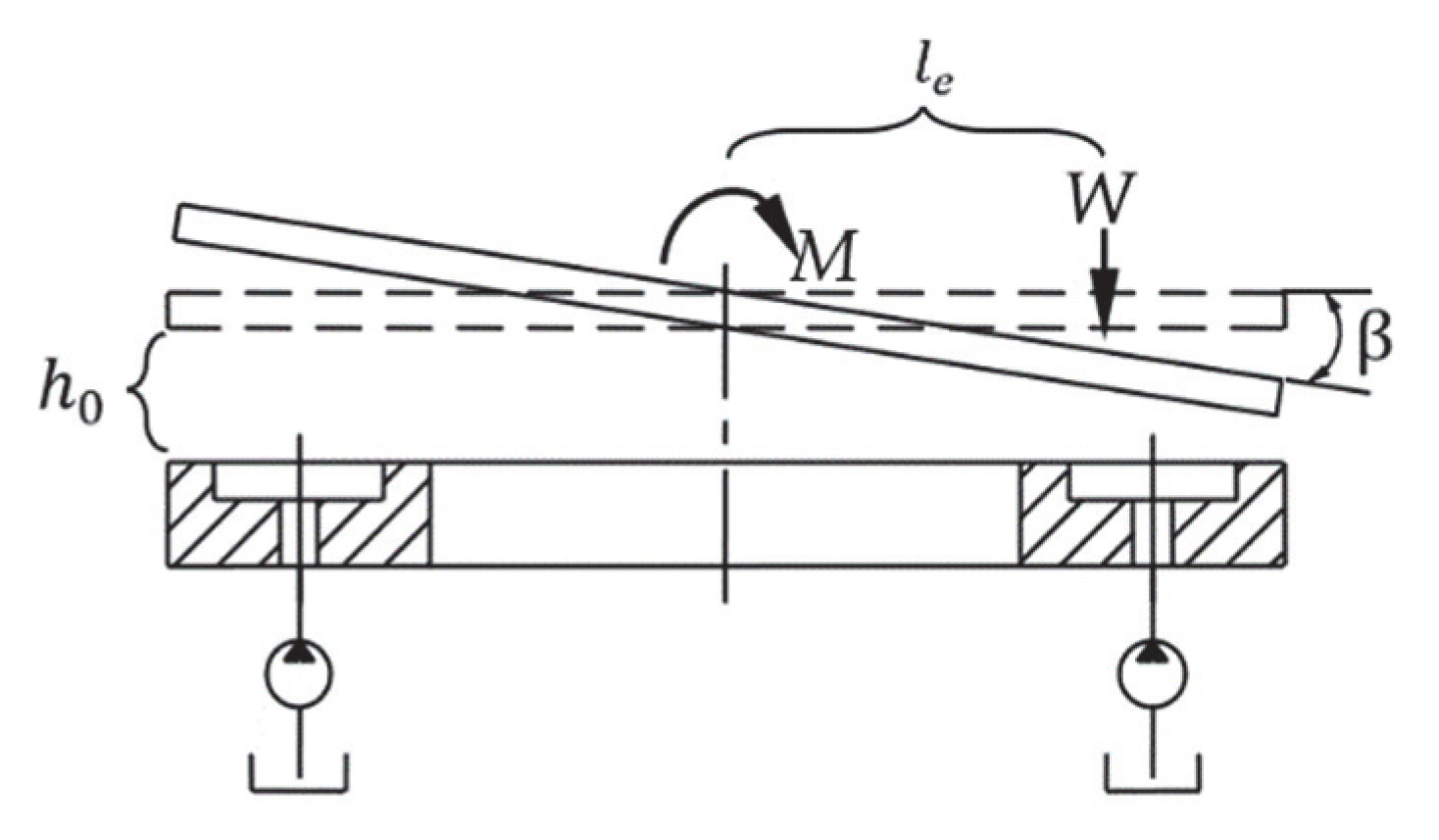

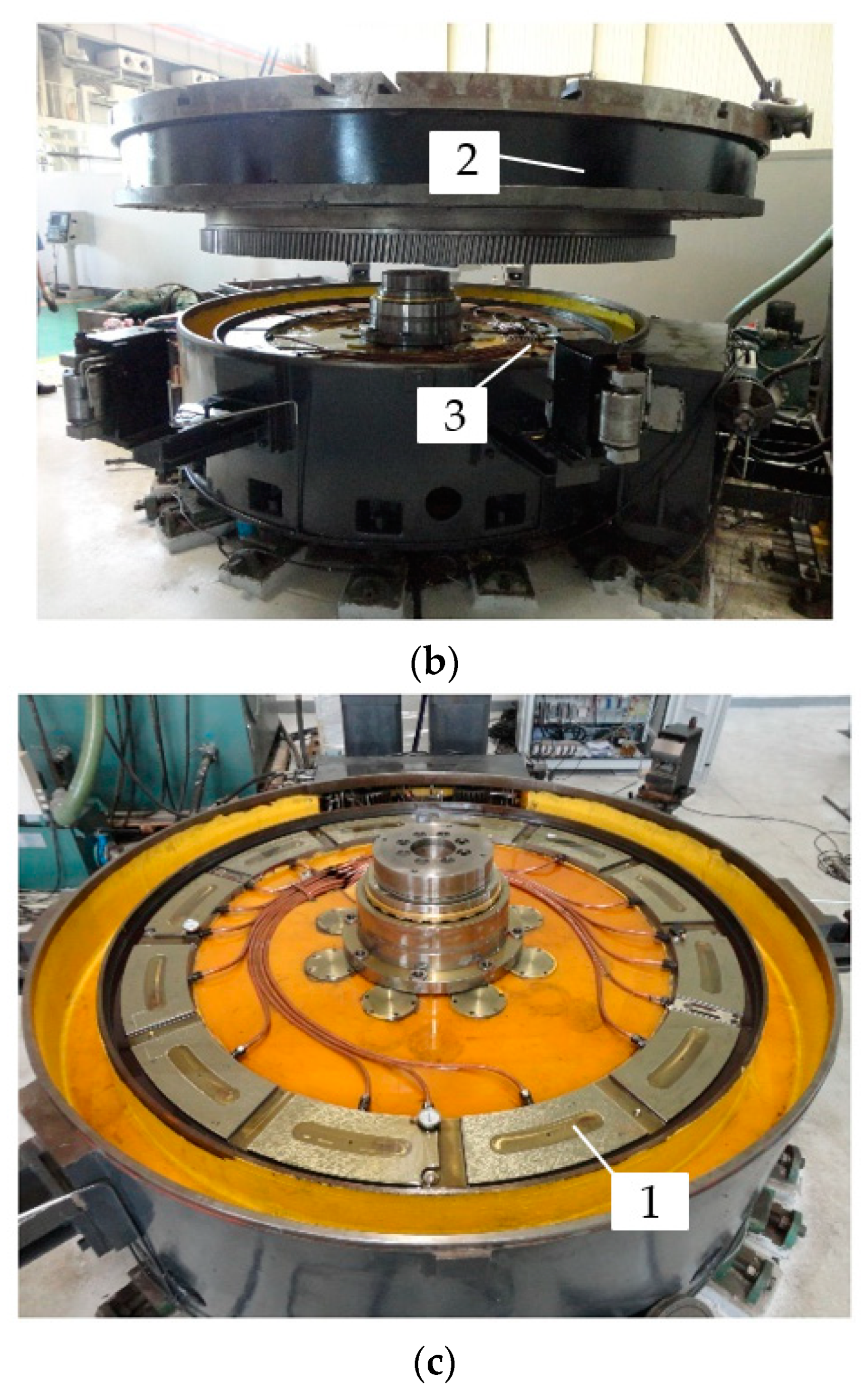




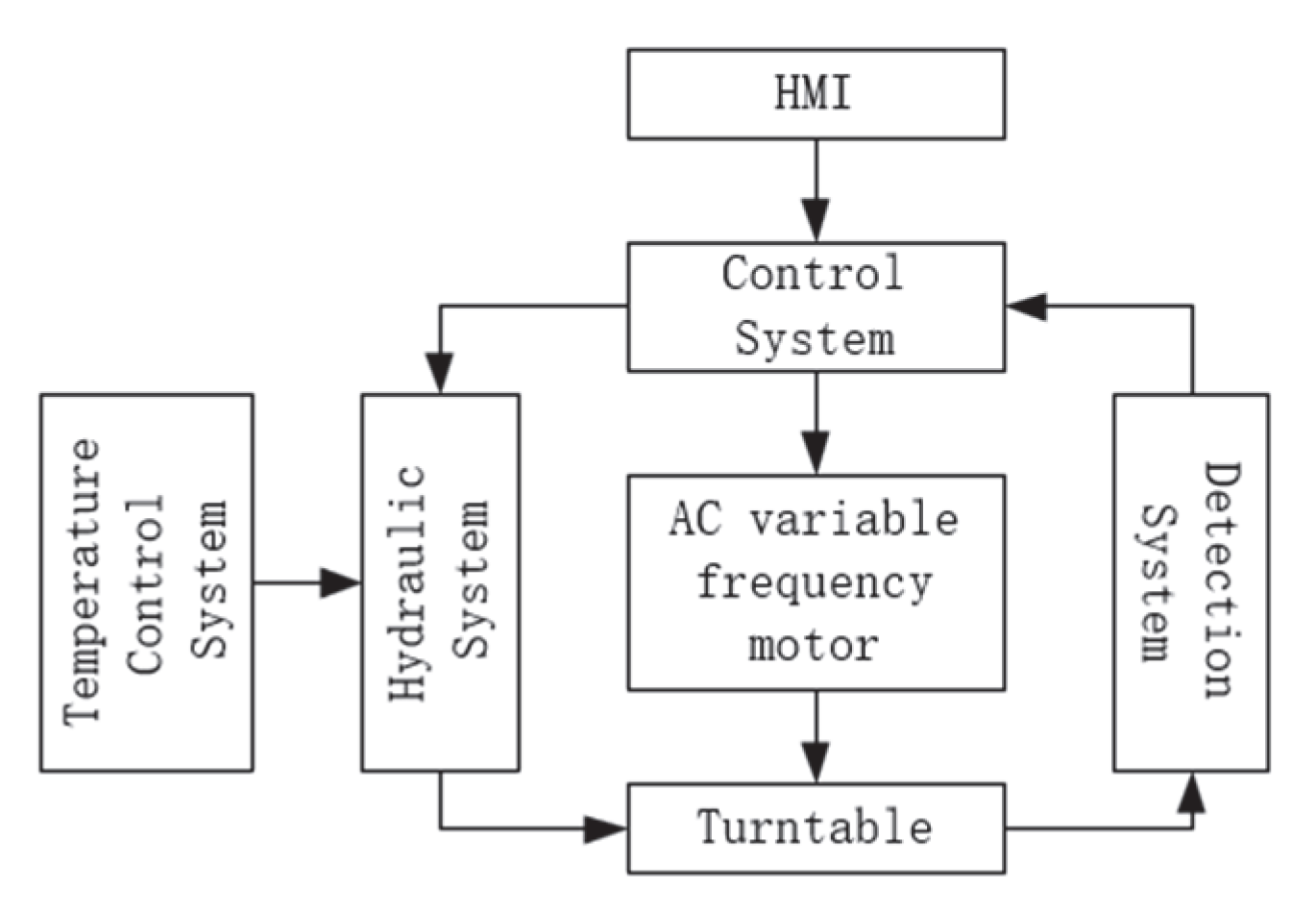
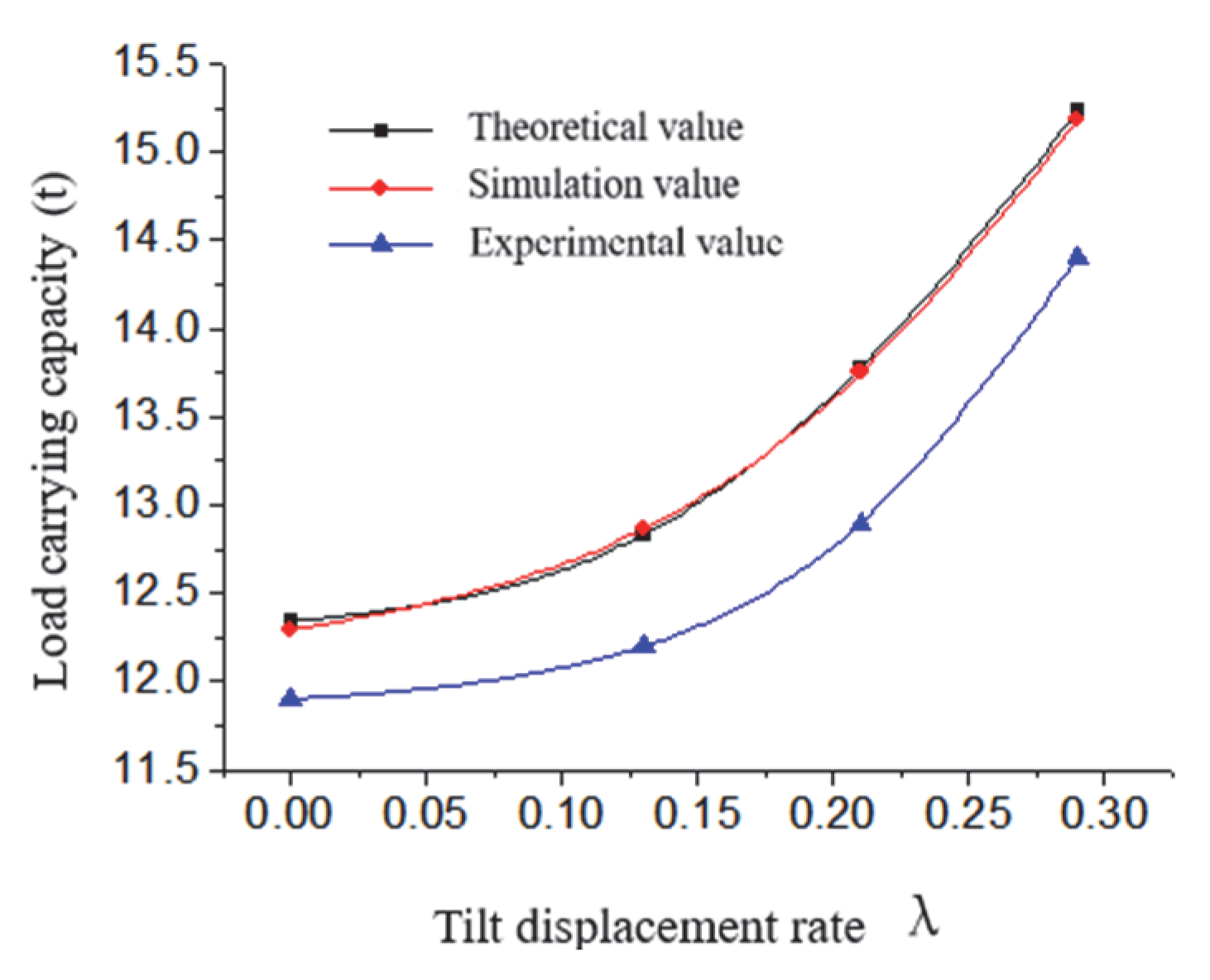
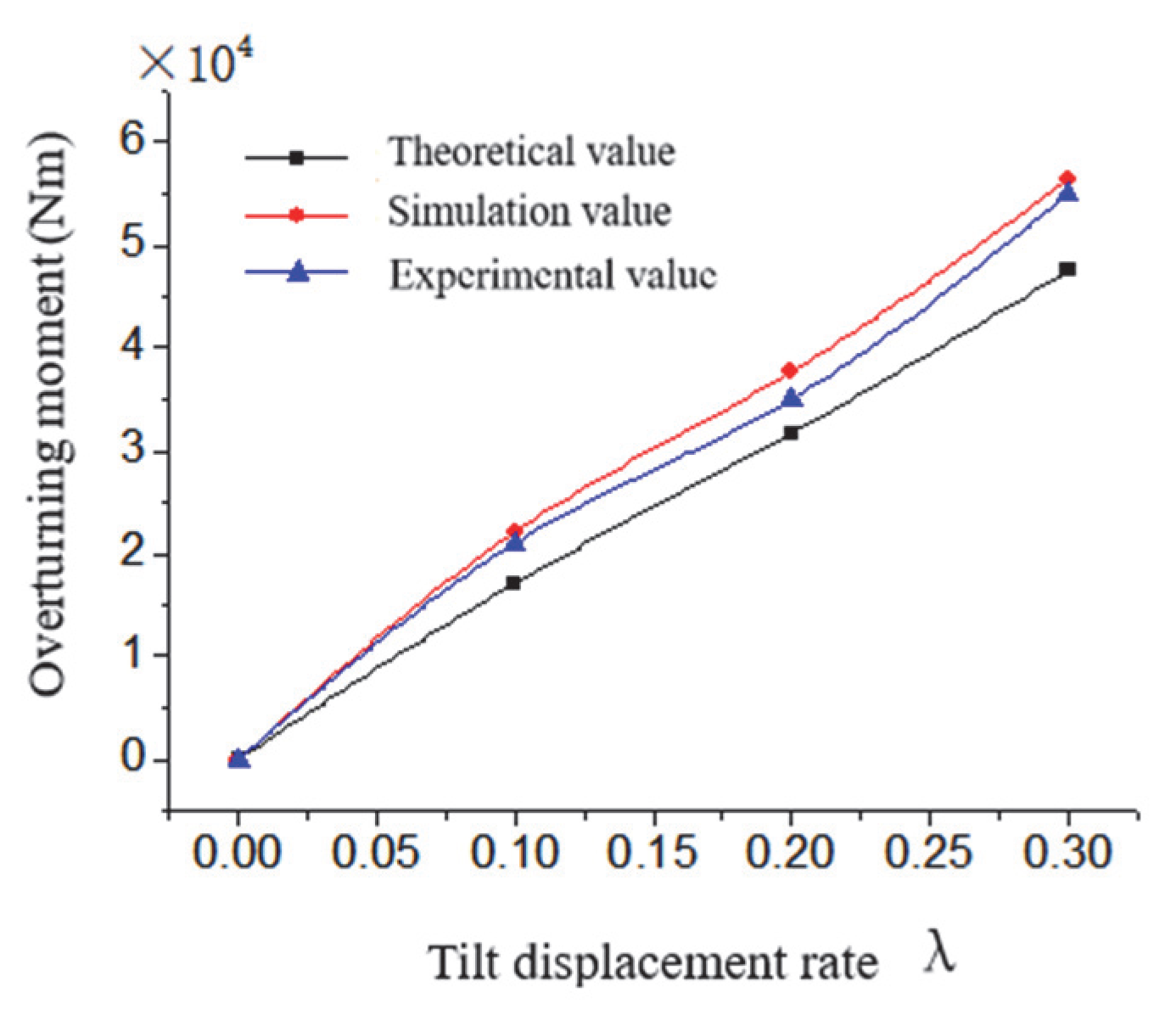

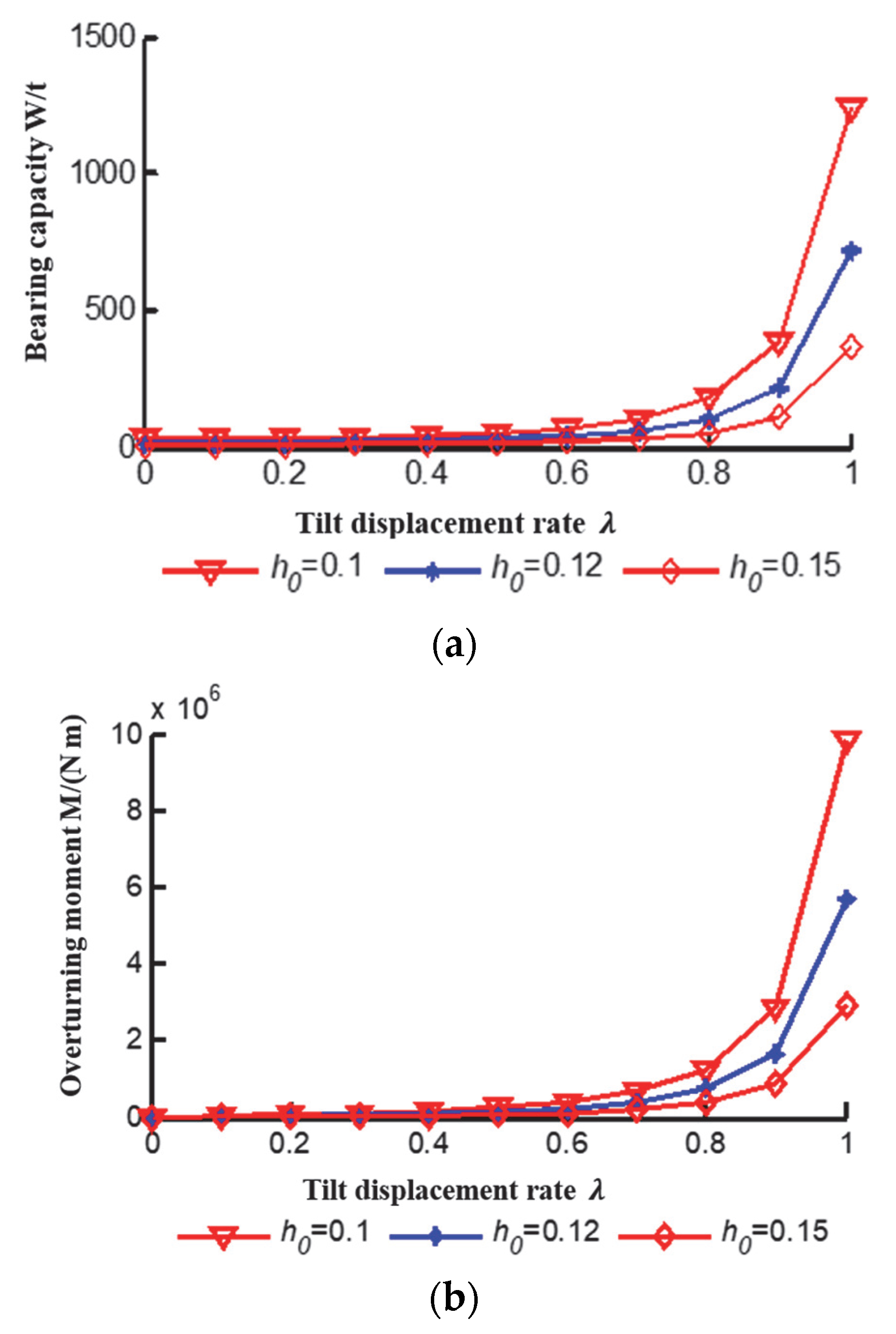
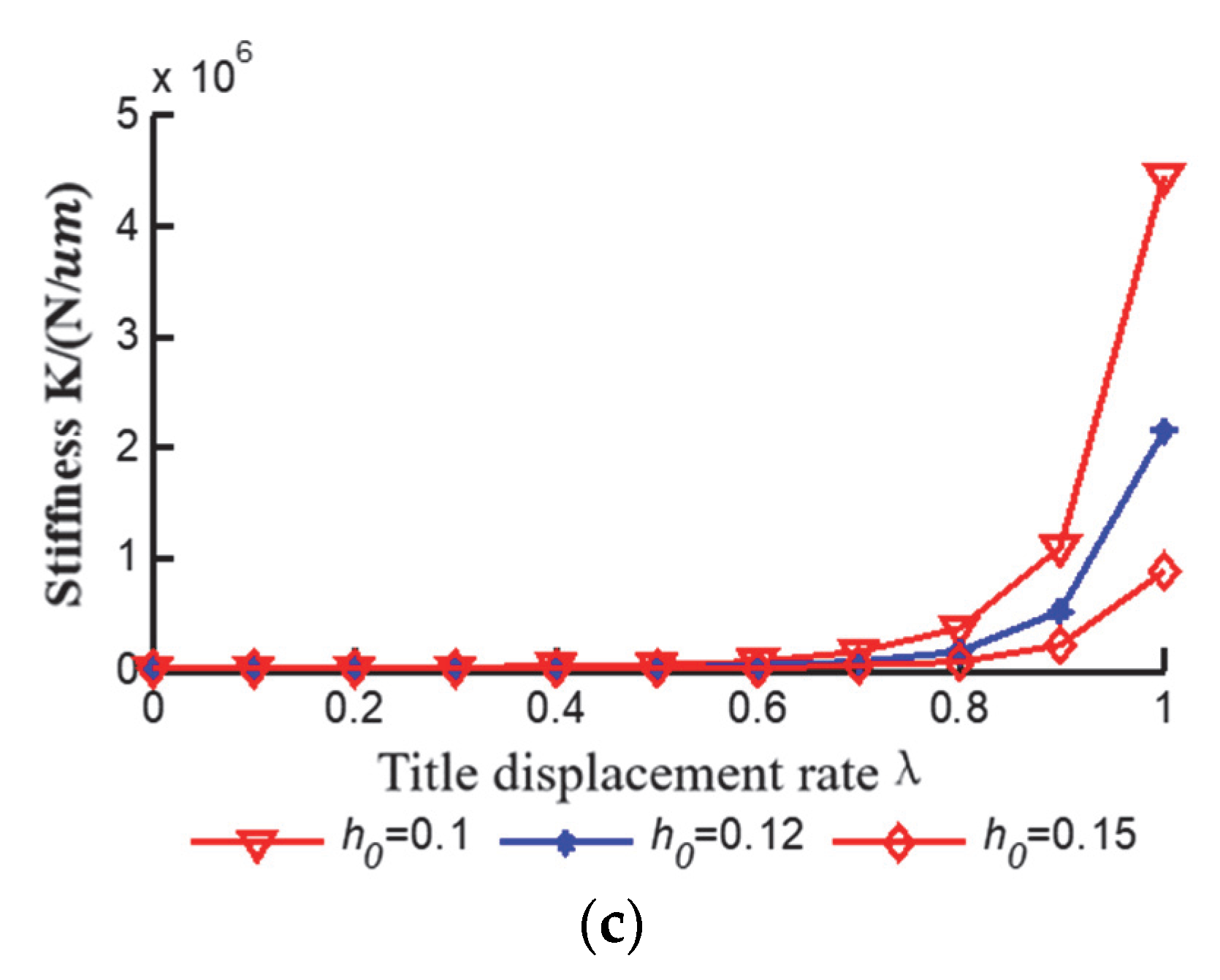

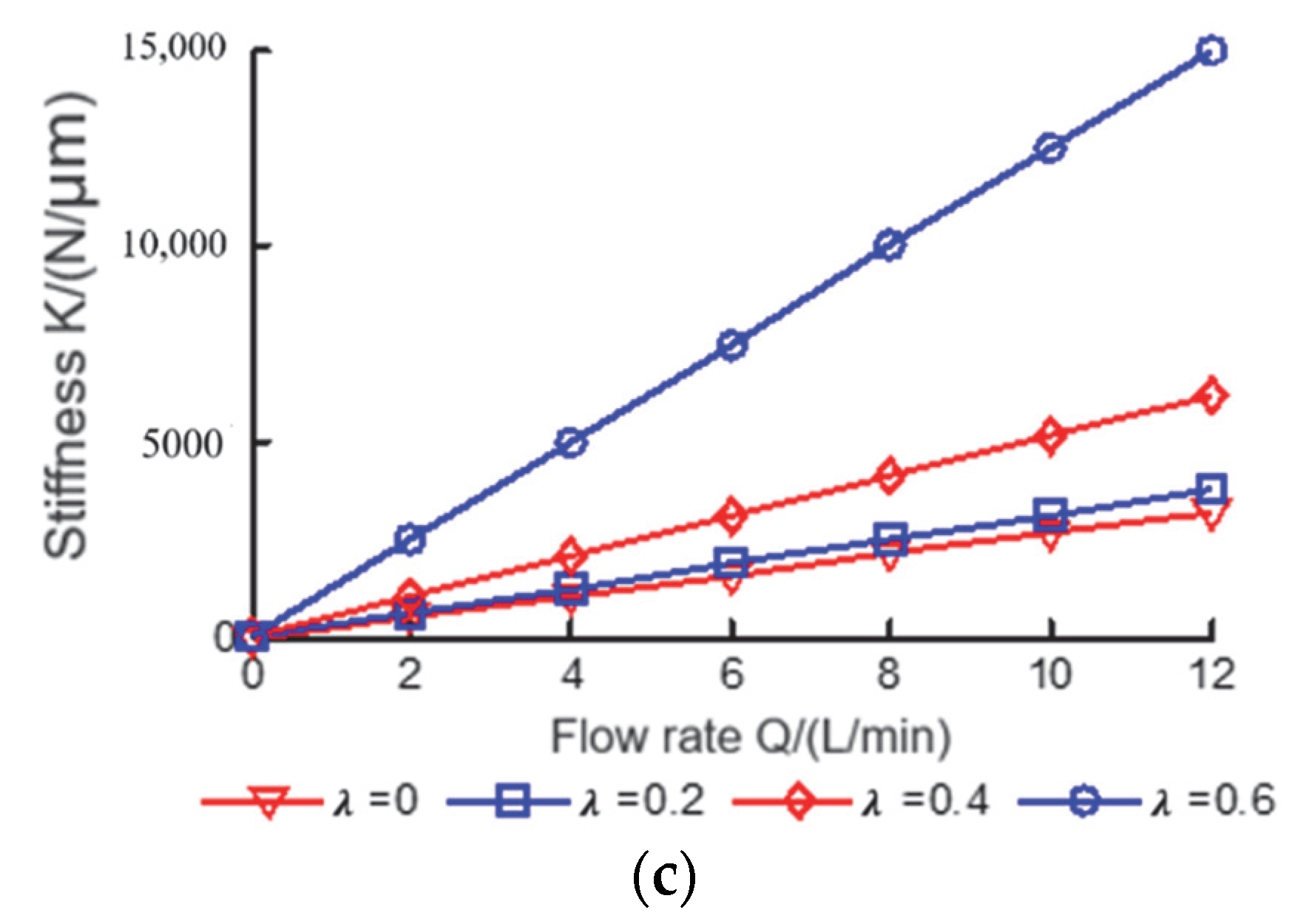


Publisher’s Note: MDPI stays neutral with regard to jurisdictional claims in published maps and institutional affiliations. |
© 2022 by the authors. Licensee MDPI, Basel, Switzerland. This article is an open access article distributed under the terms and conditions of the Creative Commons Attribution (CC BY) license (https://creativecommons.org/licenses/by/4.0/).
Share and Cite
Wang, S.; Lu, J.; Zhang, Y.; Ge, K.; Zhong, C. Analytical Research on the Bearing Characteristics of Oil Film Supplied with Constant Oil Flow Hydrostatic Turntables under Fixed Eccentric Load Condition. Processes 2022, 10, 2017. https://doi.org/10.3390/pr10102017
Wang S, Lu J, Zhang Y, Ge K, Zhong C. Analytical Research on the Bearing Characteristics of Oil Film Supplied with Constant Oil Flow Hydrostatic Turntables under Fixed Eccentric Load Condition. Processes. 2022; 10(10):2017. https://doi.org/10.3390/pr10102017
Chicago/Turabian StyleWang, Shaoli, Jie Lu, Yilin Zhang, Kehan Ge, and Chao Zhong. 2022. "Analytical Research on the Bearing Characteristics of Oil Film Supplied with Constant Oil Flow Hydrostatic Turntables under Fixed Eccentric Load Condition" Processes 10, no. 10: 2017. https://doi.org/10.3390/pr10102017
APA StyleWang, S., Lu, J., Zhang, Y., Ge, K., & Zhong, C. (2022). Analytical Research on the Bearing Characteristics of Oil Film Supplied with Constant Oil Flow Hydrostatic Turntables under Fixed Eccentric Load Condition. Processes, 10(10), 2017. https://doi.org/10.3390/pr10102017




